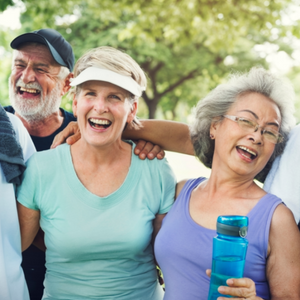
The American Heart Association and Center for Disease Control (CDC) recommend adults get 150 minutes of moderate intensity or 75 minutes of vigorous intensity exercise per week.
These recommendations are not commonly met amongst the older adult population, but it’s really important to be physically active and exercise in order to maintain and improve strength, balance, mental health, and really overall well-being.
Here are 7 quick tips to increase your activity daily!
1. Keep it Simple

Many times, starting an exercise program comes with a 30 day challenge or going to the gym five times per week, and that’s not necessary!
Pick just 5 exercises to do every day- squats, heel raises, jumping jacks, counter or kneeling push ups, and sit to stands. Do each exercise 10 times every morning.
Over time you’ll start to really look forward to the movement in the morning and may increase your repetitions or complete your routine multiple times during the day.
Keeping it simple helps give you a manageable starting point, which motivates the brain every time you complete your routine!
2. Find out what you like to do

It’s easy for me to recommend specific exercises that target important muscle groups, and while those movements are beneficial, they’re only beneficial if you do them.
Find exercise that you enjoy! That way you’ll look forward to it. And are more likely to do it consistently.
3. Aim for Progress Not Perfection

When starting a new routine or building up an old one, remember that it takes time to create new habits/change.
If you do your exercises one day a week and forget for the next six, celebrate that one-day accomplishment. Then you can decide how to set yourself up for more success the following week.
It’s about building upon success, rather than focusing on “failure.”
There’s really no failure with increasing exercise and activity level. It’s all about continuing to add more movement into your day.
4. Write Down Your Plan

For many people, taking time to write things down does increase the likelihood of completing the task.
I think of it like a grocery list. If I write down everything I want then I’m much more likely to get it all. If it’s not on the list, I’m likely to forget it or get something that I didn’t really want or need instead.
Also, creating that plan can help you determine if it’s achievable. Going from no days of activity to 7 might be too much. Take time to consider if it’s manageable.
5. Remember the Goal

For many people, a fitness goal quickly becomes about weight loss. I would like to encourage you to focus on health instead.
Getting the recommended amount of activity (or preferably more) per week can help decrease your risk for disease, improve your sleep, decrease pain, and increase strength which will improve overall well-being and help you to maintain independence.
Weight loss and health are not the same thing. Many times, a focus on weight loss causes people to stop exercising or eating well if the numbers aren’t reflected on the scale.
When it comes to improving your health, the goal is increasing activity/exercise and focusing on good nutrition. So applaud yourself for improvements in exercise level regardless of what the scale says (or maybe don’t even look at the scale!)
6. Pick a Realistic Timeframe

Studies have found that your 30 minutes a day doesn’t need to done all at once!
You can break it up into 10 minute segments if that works for you. In fact, there are many videos on my YouTube channel that you can do in 10 minutes.
If you like getting your exercise done all at once, that’s great too, but just make sure you are still getting some movement in throughout the day.
Also know that 30 minutes per day is the minimum recommendation. Feel free to do more!
7. Know You’re Tendency

The Four Tendencies quiz helps you identify how you respond to inner and outer expectations.
Basically, it helps you identify what type of accountability you need.
If you’re an Obliger (which is the majority of people), you need outer accountability, like having a friend exercise with your, or thinking about how your grandchildren will be proud that you went for a walk today.
If you’re an upholder, you may just need to make that commitment to yourself. Write it down and stick it to your fridge so you remember to exercise every morning.
Questioners need to know why it’s important. Maybe do some research on the benefits of Tai Chi, or any activity you’re interested in. Find out a “why” that resonates with you so you’re more likely to follow through.
Lastly, if you’re a Rebel, you likely will do well with a challenge. Do a 30 day Pilates or Yoga challenge or sign up for a 5K.
Understanding yourself a little better will help you to create an exercise plan that fits your style!



